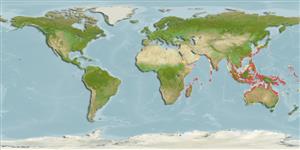>
Carangaria/misc (Various families in series Carangaria) >
Latidae (Lates perches)
Etymology: Psammoperca: Greek, psammos = sand + Greek,perke = perch (Ref. 45335).
More on author: Cuvier.
Environment: milieu / climate zone / depth range / distribution range
ນິເວດວິທະຍາ
ສັດທະເລ; ນ້ຳກ່ອຍ ກ່ຽວກັນຫີນ; ລະດັບຄວາມເລິກ 3 - 12 m (Ref. 90102). Tropical
Indo-West Pacific: Bay of Bengal, Indo-Australian Archipelago and northern Australia to the Philippines, China Sea and Japan (Ref. 2334). Found in the Mekong delta (Ref. 12693).
Length at first maturity / ຂະໜາດ / ນ້ຳໜັກ / Age
Maturity: Lm ?, range 28 - ? cm
Max length : 47.0 cm TL ຕົວຜູ້/ບໍ່ມີເພດ; (Ref. 2334); common length : 25.0 cm TL ຕົວຜູ້/ບໍ່ມີເພດ; (Ref. 9799)
ຄີ (ໜາມ)ແຂງຢູ່ຫຼັງປາ (ທັງໝົດ): 8; ຄີຫຼັງຂອງປາ (ຄີອ່ອນ) (ທັງໝົດ): 12-14; ຄີ(ໜາມ) ແຂງຢູ່ຄີກົ້ນປາ
ກຸ່ມປາກະດູກແຂງ
ຄວາມຖີ່ຂອງກຸ່ມຖ່າຍທອດພັນ
ປາທີ່ມີການເຄື່ອນຍ້າຍຈາກທະເລໄປຫານ້ຳຈືດ ແລະນ້ຳຈືດຫາທະເລ
ປາທີ່ມີການເຄື່ອນຍ້າຍຈາກທະເລແລະໄປໄຂ່ຢູ່ນ້ຳຈືດ
ຄີກົ້ນຂອງປາ
ສັດທີ່ມີກະດູກສັນຫັຼງ
ການຖ່າຍທອດທາງກຳມະພັນຈາກພໍ່ແມ່ຫາລູກ 3; ຄີກົ້ນຂອງປາ: 8; ສັດທີ່ມີກະດູກສັນຫຼັງ: 14. This species is distinguished from Psammoperca datnioides by the following set of characters: Colouration: when alive, the head and body brownish dark and often golden in colour; pored lateral-line scales yellow-edged; and similar yellowish brown colour in preserved specimens; lower counts of pored lateral line scales 46-48; hind margin of maxilla reaching slightly short of hind margin of eye when mouth closed; tiny scales that are not seen with naked eye, but visible through binocular scope, on the posterior uppermost part of maxilla; pelvic-fin spine subequal to 4th dorsal spine; circumpeduncular scale 21-22; moderately lesser body depth, 32-36% (mean 36%) of SL; lower counts, 5½ / 7½-9½ scale rows above and below lateral line; gill rakers 7 (including 6 rudiments) + 1 + 11 (including 3 rudiments) = 19 (9 rudiments); last dorsal-fin spine / penultimate dorsal-fin spine 1.5-1.7 (Ref. 124584).
Inhabits rocky or coral reefs, frequently in weedy areas, usually in holes and crevices by day. Enters estuaries (Ref. 4833). Forages on fishes and crustaceans at night (Ref. 9710). Mainly marketed fresh. In Hong Kong sold live in fish markets (Ref. 27253).
Life cycle and mating behavior
ການຈະເລີນເຕັມໄວ | ການສືບພັນ | ການວາງໄຂ່ | ໄຂ່ | ຄວາມດົກຂອງໄຂ່ປາ | ຕົວອ່ອນ
Iwatsuki, Y., S.J. Newman, F. Tanaka and B.C. Russell, 2018. Validity of Psammoperca datnioides Richardson 1848 and redescriptions of P. waigiensis Cuvier in Cuvier & Valenciennes 1828 and Hypopterus macropterus (Günther 1859) in the family Latidae (Perciformes) from the Indo-West Pacific. Zootaxa 4402(3):467-486. (Ref. 124584)
IUCN Red List Status (Ref. 130435)
Threat to humans
Harmless
Human uses
ການປະມົງ: ເປັນສີນຄ້າ; ຊະນິດປາທີ່ຖືກນຳໃຊ້ເຂົ້າໃນການຫາເພື່ອເປັນເກມກິລາ: ແມ່ນ
ຂໍ້ມູນຕື່ມອີກ
ຊື່ສາມັນຄຳສັບຄ້າຍຄືກັນການເຜົາໃໝ້ພະລັງງານໂດຍປ່ຽນທາດອາຫານໃນຮ່າງກາຍໃຫ້ກາຍເປັນຊີ້ນແລະໜັງຜູ້ລ້າການສຶກສາຜົນກະທົບຂອງສານຜິດທີ່ມີຜົນກະທົບຕໍ່ລະບົບນິເວດການສືບພັນການຈະເລີນເຕັມໄວການວາງໄຂ່ການສັງລວມການວາງໄຂ່ຄວາມດົກຂອງໄຂ່ປາໄຂ່Egg development
ເອກະສານອ້າງອີງການລ້ຽງສັດນ້ຳຂໍ້ມູນການລ້ຽງສັດນ້ຳສາຍພັນກຳມະພັນElectrophoresesການຖ່າຍທອດທາງກຳມະພັນຈາກພໍ່ແມ່ຫາລູກພະຍາດການປຸງແຕ່ງNutrientsMass conversion
ຜູ້ຮ່ວມມືຮູບStamps, Coins Misc.ສຽງຫອຍມີພິດຊະນິດນຶ່ງທີ່ອາໄສໃນທະເລຄວາມໄວປະເພດການລອຍເນື້ອທີ່ເຫືອກOtolithsສະໝອງວິໄສທັດ
ເຄື່ອງມື
Special reports
Download XML
ແຫຼ່ງອີນເຕີເນັດ
Estimates based on models
Preferred temperature (Ref.
123201): 24.7 - 29.3, mean 28.4 °C (based on 2981 cells).
Phylogenetic diversity index (Ref.
82804): PD
50 = 1.0001 [Uniqueness, from 0.5 = low to 2.0 = high].
Bayesian length-weight: a=0.01047 (0.00484 - 0.02265), b=3.02 (2.83 - 3.21), in cm total length, based on LWR estimates for this (Sub)family-body shape (Ref.
93245).
ຊັ້ນເຂດຮ້ອນ (Ref.
69278): 4.0 ±0.67 se; based on food items.
ຄວາມຢືດຢຸ່ນ (Ref.
120179): ສູງ, ປະຊາກອນຕຳ່ສຸດທີ່ໃຊ້ເວລາສອງໜ້ອຍກວ່າ 15 ເດືອນ (Preliminary K or Fecundity.).
Fishing Vulnerability (Ref.
59153): Moderate vulnerability (37 of 100).
Nutrients (Ref.
124155): Calcium = 57.9 [28.1, 102.6] mg/100g; Iron = 0.579 [0.300, 1.063] mg/100g; Protein = 20 [18, 22] %; Omega3 = 0.14 [0.09, 0.21] g/100g; Selenium = 24.4 [13.5, 47.5] μg/100g; VitaminA = 62.7 [17.8, 226.9] μg/100g; Zinc = 1.19 [0.81, 1.83] mg/100g (wet weight);
